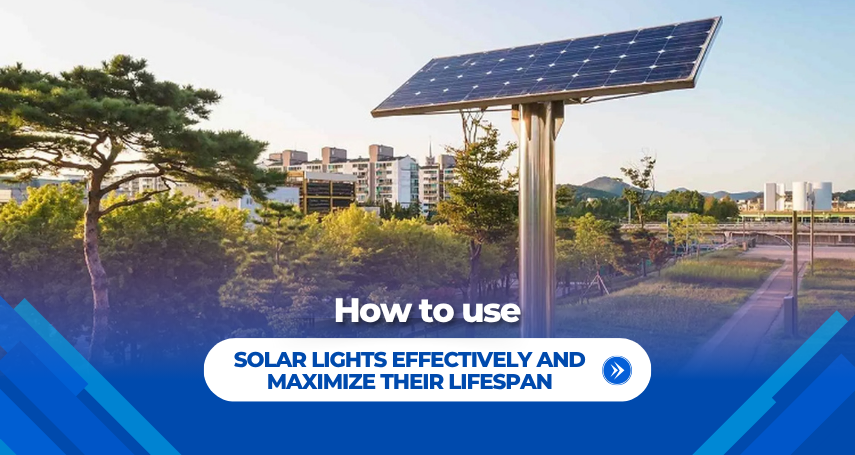Solar-powered lights are becoming increasingly popular in households, businesses, and public spaces thanks to their energy-saving capabilities and eco-friendly nature. However, to fully maximize their lighting efficiency and extend their lifespan, users need to know how to properly use these devices. The following guide provides detailed instructions — from installation and battery charging to routine maintenance.

What Are Solar Lights?
Solar lights are lighting devices that generate electricity from sunlight. Using a solar panel, sunlight is converted into electricity and stored in a rechargeable battery (usually lithium). When night falls, the stored energy powers the LED light automatically, saving electricity and requiring no manual operation.
Key Advantages:
-
Automatic operation: Charges during the day, lights up at night using light sensors.
-
Grid-independent: Saves long-term energy costs.
-
Easy installation: Suitable for various outdoor spaces like gardens, balconies, walkways.
-
Eco-friendly: Produces no harmful emissions.
How to Use Solar Lights Effectively
1. Install in the Right Position and Direction
-
Choose a location with direct sunlight for 6–8 hours per day.
-
Avoid shaded areas such as under trees, roof overhangs, or behind walls.
-
The solar panel should be angled between 15–30 degrees depending on your geographic location for optimal sunlight exposure.
-
Ensure the light and panel are securely mounted to prevent shifting due to wind or impact.
2. Charge the Battery Properly to Extend Lifespan
-
For first-time use, charge the battery under direct sunlight for 6–8 hours continuously.
-
Some models require turning on the power switch before charging.
-
Do not charge in shaded areas or behind glass windows, as it reduces charging efficiency.
3. Use Smart Lighting Modes
Check the power switch to make sure the light is turned on.
Activate suitable lighting modes:
- Motion sensor: Light turns on only when movement is detected — saves battery.
- Light sensor: Automatically switches on/off based on ambient light.
- Timer mode: Turns off automatically after a preset duration — ideal for short-term use.
4. Perform Routine Maintenance and Cleaning
-
Clean the solar panel once a month to remove dust, leaves, or bird droppings.
-
Periodically check the battery, wiring, light sensor, and motion sensor.
-
Replace the battery promptly if it shows signs of degradation or fails to charge.
5. Important Usage Notes
-
Do not place the light in areas that lack sunlight for extended periods.
-
If not in use for a long time, store the light in a dry area and charge the battery periodically to preserve it.
-
For outdoor use, choose products with waterproof ratings (IP65 or higher).
-
Check specifications before purchasing: wattage, battery capacity, lighting duration, and sensor type.
Common Solar Light Issues and How to Fix Them
1. Light Does Not Turn On at Night
Possible causes:
-
Weak or uncharged battery.
-
Power switch is off or the light sensor is blocked.
Solutions:
-
Turn on the power switch.
-
Move the light to a sunnier spot.
-
Clean the solar panel surface.
-
Replace the battery if necessary.
2. Light is Dim or Turns Off Quickly
Possible causes: Insufficient charging due to poor sunlight, degraded battery, or a dirty solar panel.
Solutions:
-
Wipe the solar panel clean.
-
Relocate the light to a better sunlit area.
-
Charge the battery under sunlight for 1–2 full days.
-
Replace the battery if performance doesn’t improve.
3. Light Turns On/Off Erratically
Possible causes: Faulty light sensor or interference from nearby light sources (e.g., street lights).
Solutions:
-
Avoid placing near other nighttime light sources.
-
Clean the light sensor and restart the light.
-
If the issue persists, check the control board for malfunctions.
4. Motion Sensor Not Working
Possible causes: Dirty sensor, obstruction, or incorrect mode settings.
Solutions:
-
Clean the sensor with a soft cloth.
-
Make sure the detection area is clear of obstructions.
-
Recheck and adjust the operating mode.
Final Thoughts
Knowing how to use solar lights correctly not only helps reduce your electricity bills but also contributes to environmental protection and prolongs the life of your lighting system. From proper installation and battery care to regular maintenance, every step matters.
Start applying these tips today and enjoy long-lasting, smart, and sustainable lighting!
Looking for high-quality solar lights?
Call our hotline now at 0968 68 8081 to get personalized consultation and the best lighting solution for your space!
You may be interested in:
- Discover A-Connection’s Clean Energy Ecosystem
- Vietnam to develop two renewable energy hubs
- Solar power is revolutionizing the global electricity industry
- Renewable Energy – A Sustainable Solution for a Green Future
- What Would Happen If the World Switched Entirely to Renewable Energy?




